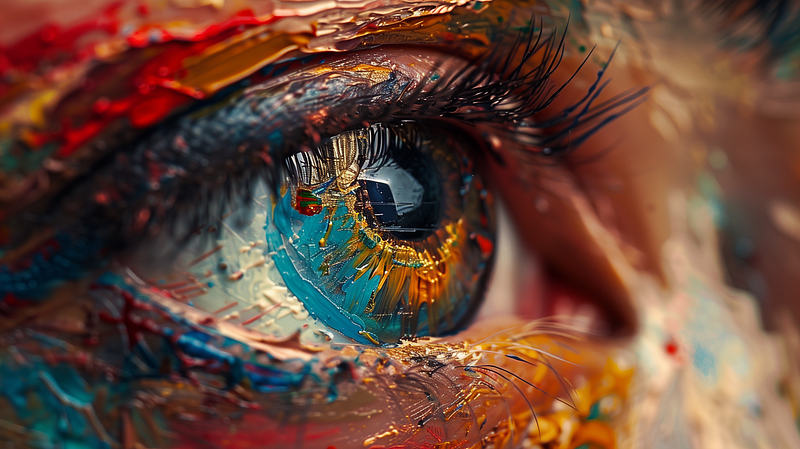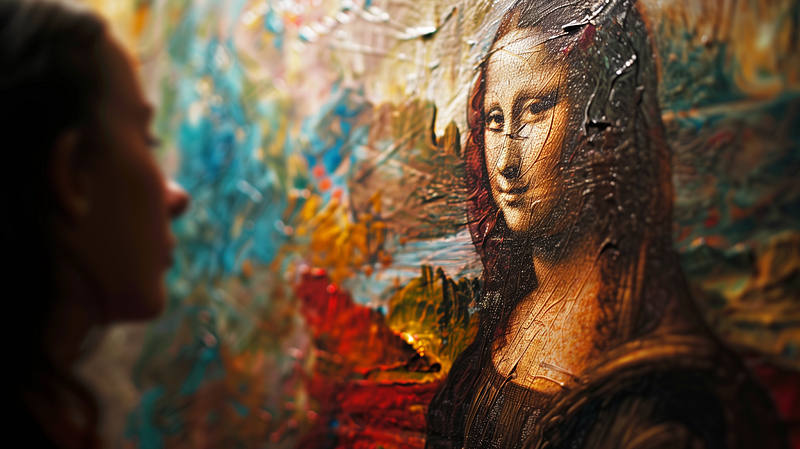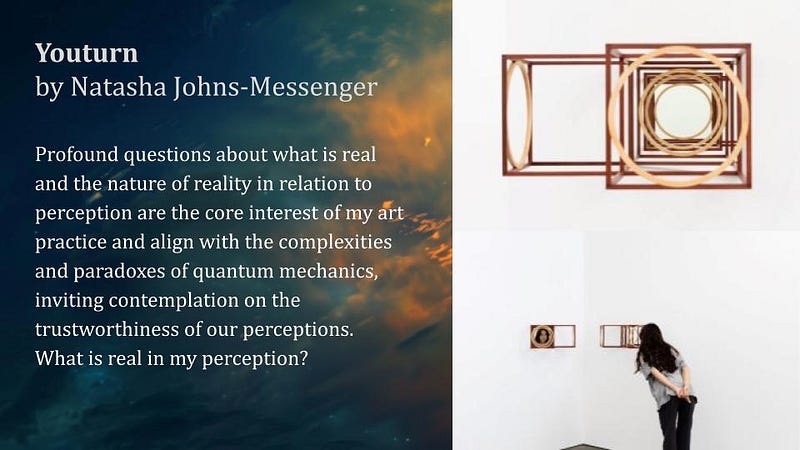<The Influence of Perception on Our Understanding of Reality>
Written on

Note: This was a public lecture to launch the DUALITY exhibition, featuring winners of a quantum art competition.
A painting is merely a surface of interlaced fibers that have absorbed a blend of resin, solvents, and other substances. Various sections of this surface contain different additives, known as pigments, which absorb certain wavelengths of light while reflecting others. Occasionally, a member of the human species perceives this reflected light and identifies it as art. The distinction between this art and the stained canvas is referred to as the beholder’s share.

While the notion can be traced back to early 20th-century art historians, it was Marcel Duchamp who audaciously quantified it, proposing that the artist contributes only half of the work. The other half is completed by the viewer. Although trying to quantify this precisely may seem trivial, the essence remains — art is a partnership between the creator and the viewer.
An artwork is not a static object with a singular interpretation; rather, it is finalized by the viewer’s perception and interpretation. This idea underscores the interactive aspect of art appreciation, where the observer actively contributes to the significance of the piece.

Now, what if I suggested that the same principle applies to reality? You are not the creator of reality but rather the observer. This means you are not merely a passive spectator of the world but an active participant in shaping, interpreting, and assigning meaning to it, just as you would with a piece of art.
From Beholders to Observers
One might assume that viewing art involves a passive observation of a physical reality imbued with some universal meaning. However, the situation is far more intricate.

Imagine I am gazing at the Mona Lisa in Paris. While I am looking at it, I am not truly seeing the artwork itself, but rather the light that has reflected off of it. The qualities of this light — its brightness and color, for instance — depend on the characteristics of the painting and the original light source. A person next to me may also see the same artwork, but they are receiving their own unique portion of the reflected light. If our environment and viewpoints are similar, the light’s characteristics relevant to perception will also be comparable.
The lens in my eye focuses this light onto the retina, which contains light-sensitive cells called photoreceptors. These cells convert the light signals into electrical signals that travel through the optic nerve to my brain. There, various visual centers interpret attributes such as color, depth, movement, and shape.
This processing relies on the physical properties of neurons, which are nearly identical for every individual due to the 99.9% of DNA shared among humans. However, the unique connections between the approximately 100 billion neurons in each brain are distinct to each person. My individual neural network encodes my experiences, memories, and emotional responses. Temporary states of my brain (often influenced by various amounts of caffeine and alcohol) can enhance or inhibit certain neural pathways, leading to a final psychological reaction that completes the artwork.
Clearly, art — as completed by the observer — is as subjective as it is active. Yet we can agree that the Mona Lisa, the early 16th-century masterpiece by Leonardo da Vinci residing in Paris, is objectively real, correct? It exists in front of me. While my imperfect vision may not reveal the atoms, scientific tools could potentially unveil them. If that were achievable, I would be an ideal beholder — someone capable of discerning the true objective nature of a piece of art. This ideal beholder would also be an ideal observer — someone who could ascertain the "true" nature of reality itself.
Physicists have pursued this for the past century, investigating the universe at increasingly fine scales in search of a god-like perspective of the cosmos. Instead, what they discovered unsettled them. This is where quantum physics comes into play.
The Classical World
If you've come across quantum physics before, you may have prepared yourself for strange and mysterious revelations about the quantum realm. But let’s take a moment to acknowledge how deeply ingrained our belief in objective reality is before I suggest that it may not exist.

Belief in an objective reality is fundamental to human cognition and essential for interacting with the world. Recognizing a stable, objective reality enhances our ability to navigate, survive, and predict outcomes through an understanding of cause and effect and the application of consistent rules. Evolutionarily, those who could perceive and plan based on unseen aspects of their environment had a survival advantage, fostering the development of this seemingly inherited trait.
As anyone who has played peek-a-boo with a child knows, the joy and surprise on a baby’s face when an object or person reappears signify their growing comprehension of object permanence. This simple game reflects developmental milestones where children begin to understand that objects and people persist even when out of sight — a concept foundational to trusting and engaging with their environment.
In contemporary society, communities are built on a collective understanding of the world. Language, laws, education, and science all depend on the assumption that there is a shared world experienced by everyone. This collective belief is reinforced through communication and education, maintaining social cohesion and cooperative behavior. Some argue that conflict arises from clashing worldviews and differing narratives about what constitutes reality.
Our intuitive understanding of objective reality was codified by classical physics principles established by figures such as Isaac Newton. This framework perceives the world as a collection of objects and phenomena that behave predictably and deterministically under physical laws. Newton’s laws depict a universe where time and space are absolute, and where objects possess specific, measurable properties like momentum and position, unaffected by the observer’s perception. This offers a reassuring vision of objectivity, certainty, cause, and effect. For instance, whether you touch a table or observe an apple falling from a tree, Newtonian physics assures you that these objects exist independently of your observation — they are real, tangible, and objective.
Enter the Quantum
In the early 20th century, quantum physics emerged as a temporary solution to issues that classical physics could not explain, with complex terms like the blackbody radiation problem and the photoelectric effect. Max Planck initiated this field in 1900 with the concept of energy quantization, followed by Albert Einstein’s 1905 proposal that light consists of quantized photons.

A decade later, Niels Bohr developed a quantum model of the atom, introducing a system where electrons occupy fixed orbits and transition between orbits by emitting or absorbing photons of quantized energy, thus explaining atomic stability and spectral lines.
In 1924, Louis de Broglie proposed that not only light but all matter exhibits both wave-like and particle-like characteristics, assigning a wavelength to everything. This theory was experimentally validated shortly thereafter via electron diffraction, demonstrating that seemingly solid matter experiences wave interference.
This was the old quantum theory, seen as corrections to classical physics, but its dual nature was frustrating. Einstein remarked,
> “It seems as though we must use sometimes the one theory and sometimes the other, while at times we may use either. We are faced with a new kind of difficulty. We have two contradictory pictures of reality; separately neither of them fully explains the phenomena…, but together they do.”
However, at that time, nearly all physicists believed that a seamless integration of these new aspects with classical theory was achievable.
Then, in 1927, Werner Heisenberg presented the uncertainty principle, stating that certain properties of a system cannot be known with arbitrary precision simultaneously. The most well-known pair is position and momentum. Quantum uncertainty dictates that one cannot know both the location of an object and its velocity at the same time.
While this may seem technical, Heisenberg highlighted the far-reaching implications, fundamentally challenging the deterministic nature of classical physics. In Newtonian physics, precise knowledge of the present allows for future predictions. This aligns with the law of causality.
The law of causality is not necessarily violated; it simply becomes inapplicable since the uncertainty relations prevent one from having "exact knowledge" at any given moment in time. Heisenberg stated,
> “Since all experiments obey the quantum laws and, consequently, the uncertainty relations, the incorrectness of the law of causality is a definitely established consequence of quantum mechanics itself.”
Small Acts of Destruction
Einstein rejected this notion. In the late 1920s, he famously debated Heisenberg, Bohr, and others, attempting to demonstrate the logical inconsistencies of the uncertainty relations. He devised clever experimental proposals to show that the position and momentum of particles could be determined using a single apparatus. Each time, Bohr illustrated the flaws in Einstein’s reasoning, including one instance where he applied Einstein’s own theory of relativity (particularly, that clocks in varying gravitational fields experience time dilation) against him.

In every case, the experimental setup intended to ascertain one property invariably rendered another uncertain. Connecting three such experiments reveals that the act of measurement must also physically affect the item under observation. As Max Jammer stated: “In brief, an experiment is a violent interference with the regular course of nature.”
In science, measuring and testing often disrupt the system being studied. In medicine, a biopsy is a clear example of a measurement that alters the organ being examined. Measuring room temperature requires transferring heat from the room to the thermometer. Assessing air pressure in a tire necessitates releasing some air. These instances illustrate what is known as the observer effect — the alteration of the observed entity due to the act of observation.
Scientists are well aware of the observer effect as one of many potential errors in experiments. However, most believe that a diligent scientist strives to eliminate such errors. The ideal observer is one who can determine the “true value” of a measured quantity without affecting the subject being examined. However, the uncertainty relations make this concept impossible.
We can further question, if we cannot define the properties of objects, in what sense do they even exist? Indeed, in what manner can we discuss them at all?
Large Acts of Creation
Ultimately, Einstein conceded that quantum physics was a coherent theory with numerous achievements but insisted it was incomplete because it could not define an objective reality. His friend recounted,
> “We often discussed his notions on objective reality. I recall that during one walk Einstein suddenly stopped, turned to me, and asked whether I really believed that the moon exists only when I look at it.”
Einstein contended that the Moon must have a definitive position in the solar system, irrespective of whether it is being observed. He maintained that a true objective reality exists, and with sufficient intelligence and caution, we could comprehend it. Einstein envisioned certain entities in the world that adhere to physical laws, having done so since the beginning of time and continuing to do so, regardless of observer presence.
However, Bohr and others argued that much of the issue stems from language. Bohr, known for his complex prose, stated,
> “In the case of quantum phenomena, the unlimited divisibility of events implied in such an account is, in principle, excluded by the requirement to specify the experimental conditions. Indeed, the feature of wholeness typical of proper quantum phenomena finds its logical expression in the circumstance that any attempt at a well-defined subdivision would demand a change in the experimental arrangement incompatible with the definition of the phenomena under investigation.”
What could this possibly mean? The essence is this: what you measure is defined by the method used to measure it. You can attempt to probe deeper and deeper, but each iteration necessitates a different experiment. Eventually, the experiment becomes so altered that it no longer serves its original purpose. In essence, experiments define the subject of investigation — modify the experiment, and the subject changes.
Heisenberg articulated this more clearly, stating,
> “If one wants to clarify what is meant by ‘position of an object,’ they have to describe an experiment by which the ‘position of an object’ can be measured; otherwise, this term has no meaning at all.”
What does it mean for the Moon to “exist?” It likely requires at least a position along with various other attributes. Quantum physics compels us to confront what should be an evident truth: measuring properties necessitates interaction. How could it be otherwise? Complete isolation between observers and the world? In that case, there would be no world to perceive.
John Wheeler emphasized this succinctly:
> “No phenomenon is a real phenomenon until it is an observed phenomenon.”
You might think that kicking a large stone reveals its reality. Yet, it merely demonstrates that engaging with your environment requires interaction. At the quantum level, where the fundamental phenomena that constitute the universe reside, the observer effect is unavoidable.
Pascual Jordan extended this reasoning to its logical extreme, asserting,
> “Observations not only disturb what has to be measured, they produce it… We compel particles to assume a definite position… We ourselves produce the results of measurements.”
Wheeler termed this the Participatory Anthropic Principle, which posits that “reality” consists of the answers we obtain by posing questions to Nature. Without inquiries, nothing would be answered — thus, we actively participate in the creation of events. Moreover, duality dictates that the responses we receive depend significantly on the questions we pose. Choose to measure position, and the particle’s location manifests in reality while its momentum becomes something that never existed.
